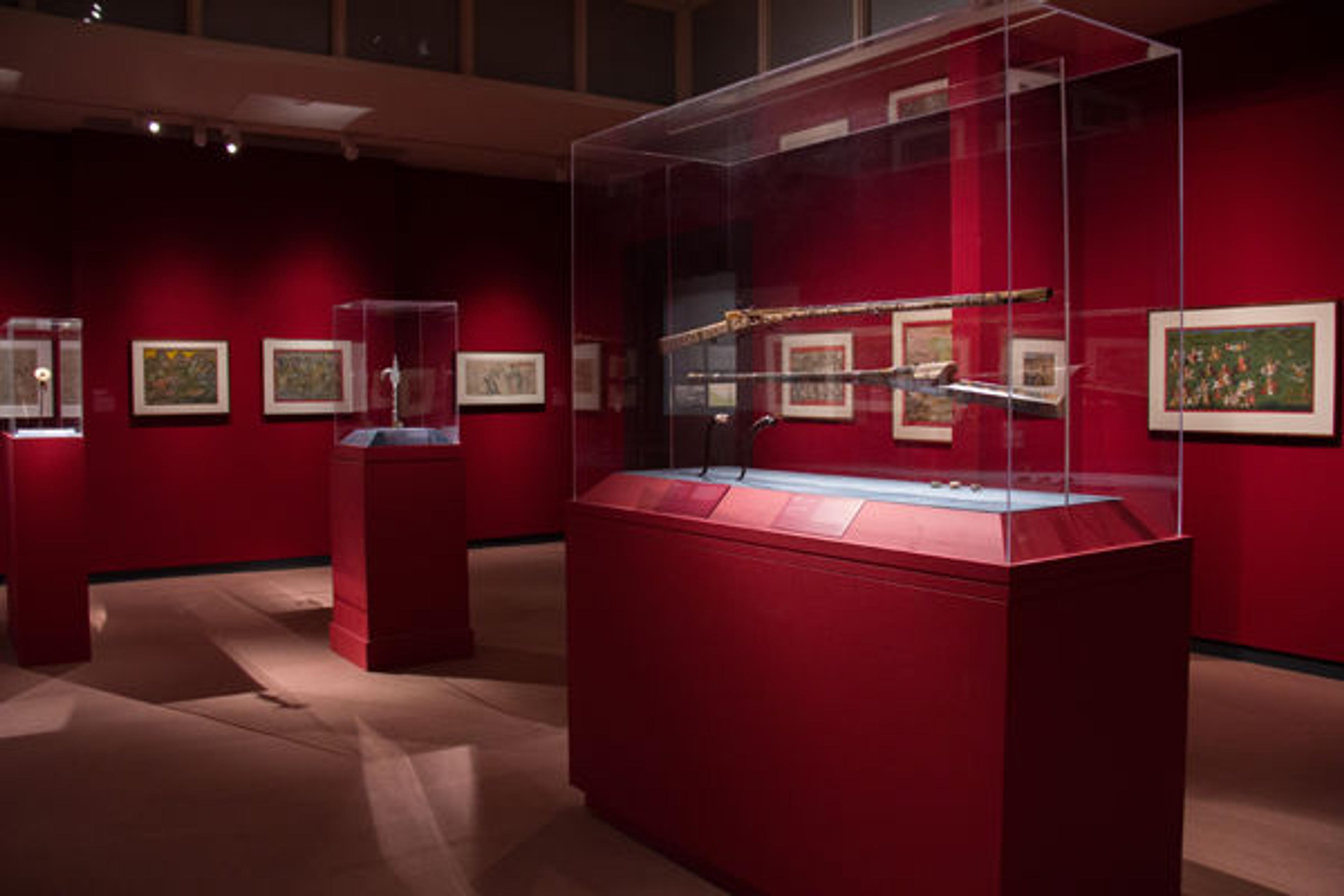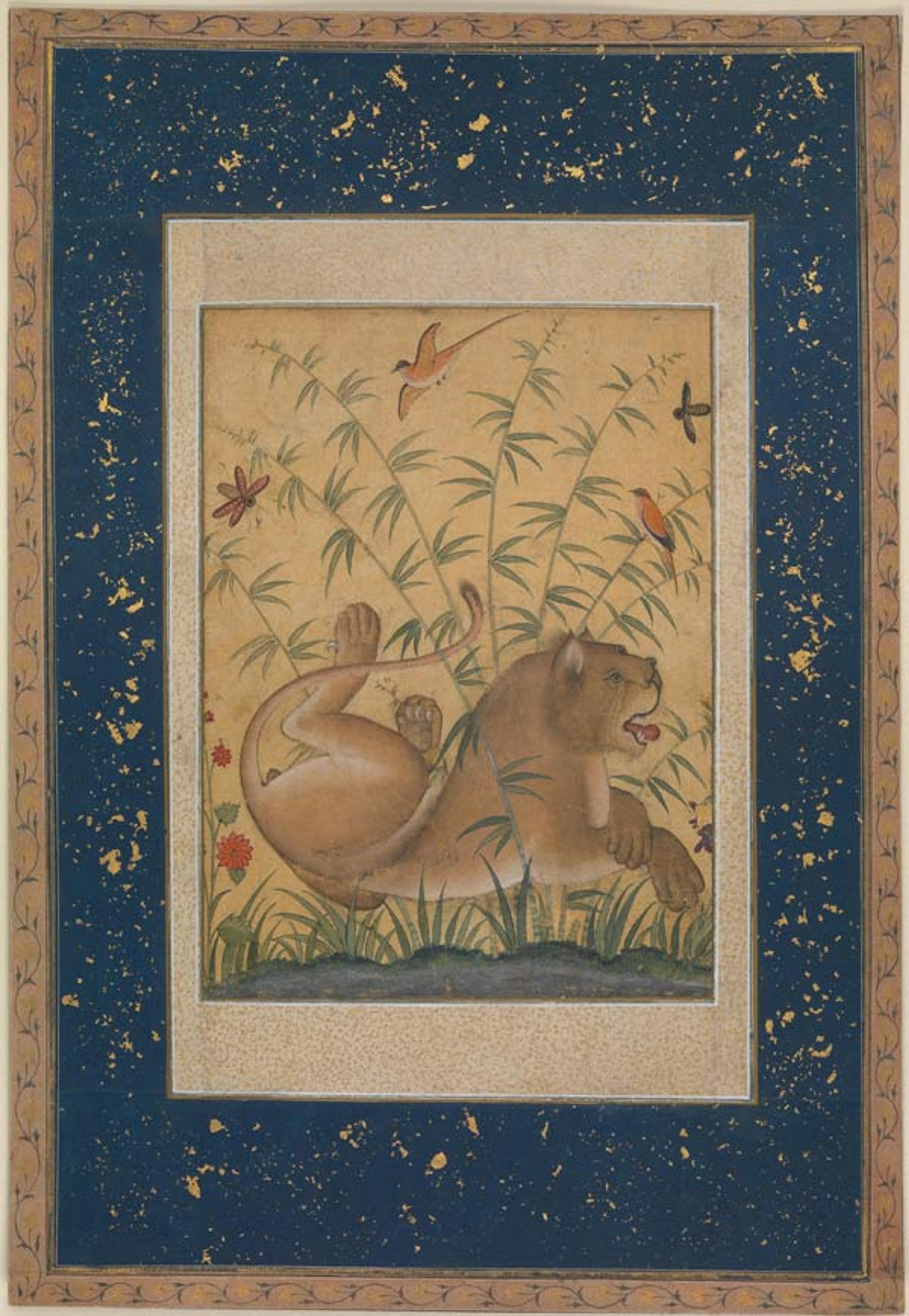Unfolding the Narrative: Depictions of the Royal Hunt

Gallery view of The Royal Hunt: Courtly Pursuits in Indian Art, which comprises paintings and regalia drawn from the permanent collections of the Met's Department of Asian Art, the Department of Islamic Art, and the Department of Arms and Armor, as well as a few objects on loan from private collections.
«As a recent graduate intern in the Department of Asian Art, I had the chance to observe the installation of the exhibition The Royal Hunt: Courtly Pursuits in Indian Art, on view through December 8, 2015. This was a rare opportunity for me to not only interact with a diverse set of experts across the Museum, all of whom worked collaboratively towards putting the exhibition together, but especially to examine up-close the objects on display.»
The central focus of the exhibition is the representation of the royal hunt, or shikar, as a metaphor for imperial authority in Indian art. This royal pastime is also a demonstration of martial prowess, an extension of warfare during periods of peace, which in some contexts serves as a tool to compensate for waning political power.
I was particularly drawn to the Mughal miniature paintings from the late sixteenth and seventeenth centuries that adorn the walls of this exhibition. While Mughal court painters documented hunts in the same manner as a military campaign, it seems to me as though the scenes depicted in these paintings may also be seen as chronicles of the natural world. Upon closer inspection, it is immediately clear that the floral and faunal landscape in each painting not only sets the scene within which the narrative of the hunt unfolds, but is also a crucial part of its telling.

"Akbar Hunting," folio from an Akbarnama (History of Akbar), late 16th century. Present-day Pakistan, probably Lahore. Islamic. Opaque watercolor, ink, and gold on paper; Painting: 7 1/2 x 4 7/8 in. (19.1 x 12.4 cm). The Metropolitan Museum of Art, New York, Rogers Fund, 1911 (11.39.2)
The painting entitled Akbar Hunting is a rather striking image of a royal hunting expedition that was once part of a complete illustrated manuscript of the Akbarnama (History of Akbar). The scene is set in the clearing of a dense thicket and against the backdrop of rugged terrain. In the center of this painting is the emperor Akbar surrounded by an entourage of mounted huntsmen, noble companions, and courtiers. This enclosed formation or stockade created by the imperial battue in order to facilitate the royal hunt is characteristic of the qamargah hunting technique, which emphasizes the military strength of the king by equating the practice of the royal hunt to that of a battle. The sense of movement across the visibly undulating terrain depicted here especially contributes to the atmosphere of combat: riding his royal steed, Akbar lunges forward as he drives his long-bladed shamshir shikargar (hunting sword) into the flesh of a leaping lioness, the trophy of this hunt.
A hunt such as this one would have demanded large resources and tremendous skill, making a successful campaign a signifier of the emperor's ability to overcome these practical challenges, thereby establishing his infallibility. Furthermore, the lion hunt was the prerogative of the emperor, and so it is evident that the spectacle depicted here is also one of a symbolic victory, further emphasizing the self-representation of Akbar as the ultimate embodiment of valor.
Nevertheless, it is the figure of the lioness partially hidden behind the foliage that caught my eye, as it especially reminds me of the painting Lion at Rest that is displayed nearby in the gallery.

Lion at Rest, ca. 1585. India. Islamic. Ink, opaque watercolor, silver, and gold on paper; Painting: 8 x 6 in. (20.3 x 15.2 cm). The Metropolitan Museum of Art, New York, The Alice and Nasli Heeramaneck Collection, Gift of Alice Heeramaneck, 1985 (1985.221)
This portrait of a resting lion also originates in the period of emperor Akbar's reign (r. 1556–1605). It is an early painting by Ustad (master) Mansur, an important figure in Mughal courts and the Akbari atelier in the late sixteenth century. The production of numerous scientifically precise studies of the natural world subsequently earned Ustad Mansur the title of Nadir al-Asr (Wonder of the Age)—the highest honor bestowed in the court of emperor Jahangir (r. 1605–1627).
This portrait is in the single-page format that developed into the muraqqa (imperial albums) genre around this time. The outermost border, one of three that frame this painting, contains delicately stylized floral, leaf, and vine motifs. The elegance of the serene but attentive quality of the resting lion is further heightened by the presence of birds and insects that flit about the grove of bamboo, bulrushes, and flowers on the banks of a lake.
The exquisitely ornamented illustration of this idyllic landscape is significant not only for the juxtaposition of naturalism and fancy, but also because of its whimsical portrayal of camouflaging. The artistic mastery of this theme echoes a strategic use of the surrounding vegetation and landscape as a masking mechanism while embarking upon a royal hunt.

Preparations for a Hunt, ca. 1680. India. Islamic. Opaque watercolor on paper; H. 6 5/8 in. x W. 11 in. (16.8cm x 27.9 cm). The Metropolitan Museum of Art, New York, Purchase, Friends of Islamic Art Gifts, 2015 (2005. 235a)
Preparations for a Hunt contains within it a larger terrain than the tightly knit composition of Akbar Hunting, and also presents a much starker landscape than the latter. In the foreground of this charming illustration are four huntsmen disguised in green outfits who are seen crouching quietly behind leafy screens, invisible to a herd of unsuspecting nilgais, which allows them to skillfully rein in the grazing animals from across the vast expanse of land. This painting depicts a scene of patient preparation in which the huntsmen anticipate the arrival of the complete hunting retinue, shown here as a great battalion, one presumably led by the emperor, and rapidly approaching the scene from the distant horizon.
The subject of this miniature provides an interesting context to the spontaneous heroism often associated with official portraits of rulers engaged in the royal hunt, choosing instead to detail the practice of discreetly contemplating and manipulating prey until it is vulnerable enough for a timely attack. Here the landscape is neither representative of pure artistic flourish nor incidental to the narrative of the painting; rather, it is key to the practice of the royal hunt, and finds expression in many captivating painterly illuminations.
Resources
Beach, Milo. The Imperial Image: Paintings for the Mughal Court. Washington, D.C.: Freer Gallery of Art, Smithsonian Institution, 1981.
Kossak, Steven M., ed. Indian Court Painting 16th–19th century. New York: The Metropolitan Museum of Art, 1997.
Guy, John, and Jorrit Britschgi. Wonder of the Age: Master Paintings of India, 1100–1900. New York: The Metropolitan Museum of Art, 2011.
Related Links
The Royal Hunt: Courtly Pursuits in Indian Art, on view June 20–December 8, 2015
Now at the Met: "Decorous and Deadly: Weapons of the Royal Hunt in India" (September 10, 2015)
Kalyani Ramachandran
Kalyani Madhura Ramachandran was formerly the Solow graduate intern in South and Southeast Asian Art in the Department of Asian Art.